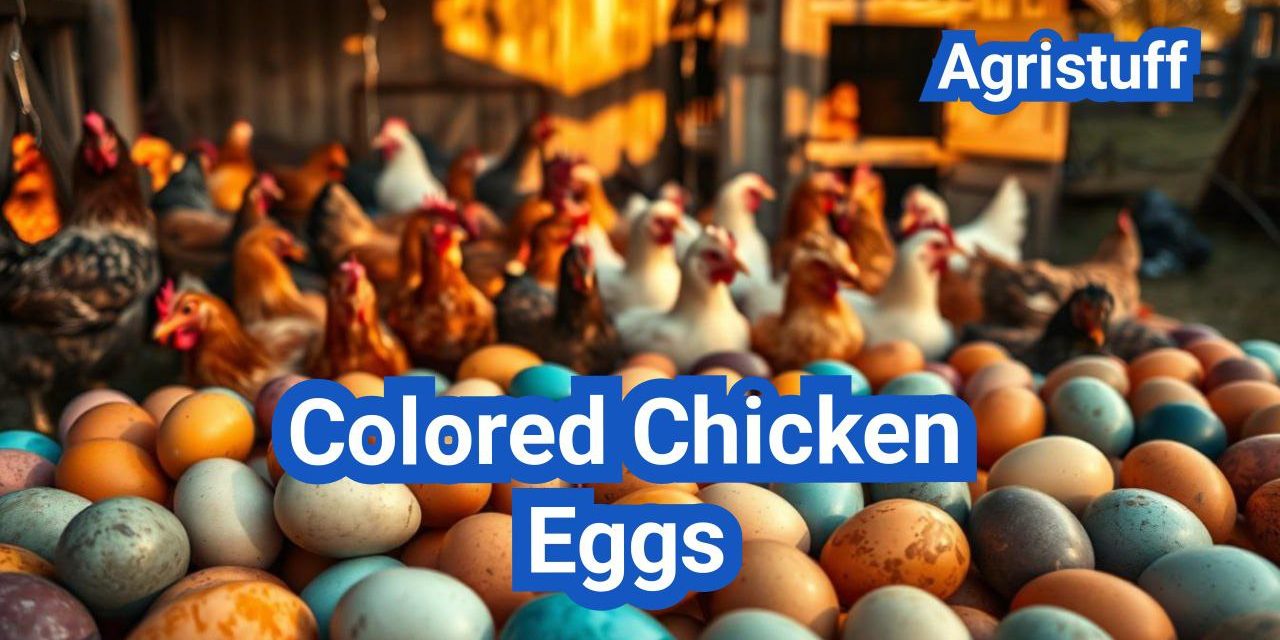The world of colored chicken eggs is a fascinating one, with various breeds laying eggs in a range of colors, including white, brown, blue, green, and even pink.
Different chicken breeds have unique characteristics that determine the color of the eggs they lay. For instance, some breeds lay eggs with a blue or green tint, while others produce eggs with a rich, dark brown color.
This diversity in egg color is not only visually appealing but also reflects the rich genetic diversity among chicken breeds.
Key Takeaways
- Various chicken breeds lay eggs in different colors.
- Egg color is determined by the breed’s genetic characteristics.
- The range of egg colors includes white, brown, blue, green, and pink.
- Some breeds are known for laying eggs with unique colors.
- The diversity in egg color reflects the genetic diversity among chicken breeds.
The Fascinating World of Colored Chicken Eggs
Beyond the mundane white and brown eggs, lies a vibrant world of colored eggs, enticing chicken keepers with their beauty and uniqueness. The diversity in eggshell colors has captivated many, turning the simple act of collecting eggs into a delightful experience.
The Natural Rainbow of Eggshell Colors
The natural world of chicken eggs is a kaleidoscope of colors, ranging from soft pastel hues to deep, rich tones. Colorful chicken egg layers have become a favorite among backyard chicken enthusiasts, offering a variety of different colored chicken eggs that are as much a joy to collect as they are to behold.
From the rare colored chicken eggs laid by certain breeds to the more common yet still beautiful eggs, the variety is staggering. Breeds like the Araucana and Ameraucana are known for their blue eggs, while others like the Marans produce dark, chocolate-brown eggs.
Why Backyard Chicken Keepers Love Colored Eggs
Backyard chicken keepers love colored eggs for their beauty and the unique charm they bring to the hobby. Collecting natural colored chicken eggs becomes a daily adventure, as the color and sometimes the pattern of the eggs can vary significantly.
The appeal of colored eggs also lies in their genetic uniqueness. The color of an eggshell is determined by genetics, making the collection of eggs a fascinating display of nature’s diversity. Whether it’s the deep blue of an Ameraucana egg or the speckled pattern of a Welsummer egg, each egg is a testament to the breed’s characteristics and the wonders of genetics.
Understanding the Science of Eggshell Coloration
Eggshells owe their diverse colors to a combination of genetic factors and specific pigments. The science behind eggshell coloration is complex, involving various biological processes.
Eggshell Pigments: Biliverdin and Protoporphyrin Explained
The primary pigments responsible for eggshell color are biliverdin and protoporphyrin. Biliverdin produces blue or green shades, while protoporphyrin creates red, brown, or speckled patterns. The interaction between these pigments determines the final eggshell color.
Biliverdin is a breakdown product of hemoglobin, and its presence in eggshells is influenced by genetics. Protoporphyrin, on the other hand, is related to the production of heme, a crucial component of hemoglobin. The combination and concentration of these pigments result in the wide range of eggshell colors observed.
Egg Color Genetics in Chickens
The genetics of egg color in chickens is intricate, involving multiple genes that interact to produce the final eggshell color. The genetics determines not only the presence of pigments but also their distribution on the eggshell.
Research has identified several genes that influence egg color, including those that control the production and deposition of biliverdin and protoporphyrin. Understanding these genetic factors can help breeders predict and manipulate egg colors in their flocks.
For instance, certain breeds like the Araucana and Ameraucana have genetic traits that result in blue or green eggs due to the presence of biliverdin. Other breeds, such as Marans, lay dark brown eggs because of higher levels of protoporphyrin.
Blue Egg Laying Chicken Breeds

The allure of blue eggs has led many to explore chicken breeds that lay these distinctive eggs. Blue egg laying chicken breeds have become increasingly popular among backyard chicken keepers and enthusiasts alike.
These breeds not only add a touch of uniqueness to the egg collection but also bring a fascinating genetic aspect to poultry keeping. The blue coloration is primarily due to the presence of oocyanin, a pigment applied during the laying process.
Araucana: The Original Blue Egg Layer
The Araucana breed, originating from Chile, is known for its ability to lay blue eggs. This breed is unique due to its genetic makeup, which includes the gene responsible for the blue eggshell color. Araucanas are also known for their lack of tail feathers and tufted cheeks, making them a distinctive addition to any flock.
Araucana Characteristics: They are generally friendly, although they can be somewhat skittish. Their egg-laying ability is moderate, producing around 3-4 blue eggs per week.
Ameraucana: American Blue Egg Varieties
Developed in the United States, the Ameraucana breed was derived from the Araucana. Ameraucanas are known for their blue eggs, as well as their muffs and beards. They are more cold-hardy than Araucanas and come in a variety of colors.
Ameraucana Traits: They are known for being friendly and docile, making them a great choice for families. Ameraucanas lay around 3-4 blue eggs per week.
Cream Legbar: Auto-Sexing Blue Egg Layers
The Cream Legbar is another breed known for laying blue eggs, although they can also lay cream-colored eggs. This breed is auto-sexing, meaning chicks can be sexed at hatch based on their coloration. Cream Legbars are known for their high egg production and are generally active and friendly.
Cream Legbar Features: They are prolific layers, producing around 4 eggs per week. Their friendly nature and high production make them a popular choice among backyard keepers.
Green Egg Laying Chicken Breeds
The genetic diversity of chickens has led to the development of breeds that lay eggs in a variety of colors, including green. This phenomenon is not just a result of natural breeding but also of careful selection by poultry enthusiasts.
Easter Eggers: Colorful and Varied
Easter Eggers are known for their ability to lay a range of egg colors, including green, blue, and sometimes even pink or olive. They are not a pure breed but are often the result of crossing an Ameraucana or Araucana with another breed. This genetic mix contributes to their varied egg-laying capabilities.
When comparing Easter Eggers vs. Ameraucanas, it’s essential to understand that while Ameraucanas are a recognized breed known for laying blue eggs, Easter Eggers can lay a broader spectrum of colors due to their mixed heritage.
Olive Eggers: Creating Dark Green Eggs
Olive Eggers are another example of breeds that lay green eggs, specifically a darker, olive green shade. They are typically created by crossing a breed that lays dark brown eggs (like Marans) with one that lays blue or green eggs (such as an Ameraucana or Araucana). The result is a unique egg color that combines the genetics of both parents.
The olive egger genetics involve a complex interplay of pigments. The dark brown pigment from breeds like Marans mixes with the blue pigment from breeds like Ameraucanas, resulting in an olive green color.
Starlight Green Eggers and Other Green Varieties
Starlight Green Eggers are a more recent development in the world of colored egg layers. They are known for their vibrant green eggs and are often the result of specific breeding programs aimed at creating new and interesting egg colors.
Other green egg-laying varieties exist, each with their unique characteristics and genetic backgrounds. These breeds continue to captivate chicken enthusiasts and backyard keepers alike, offering a colorful addition to any egg collection.
Brown and Chocolate Egg Laying Breeds

The world of chicken breeds that lay brown or chocolate eggs is vast and intriguing. These breeds are sought after for their unique egg colors and characteristics.
Marans and Blue Copper Marans: Chocolate Brown Specialists
The Marans breed is renowned for its dark, chocolate-brown eggs. Originating from France, Marans chickens are a favorite among egg enthusiasts. The Blue Copper Marans variety adds a unique twist with its feather coloring, but it’s the egg color that remains the main attraction. Marans eggs are not just brown; they are a rich, dark chocolate color that can vary in intensity.
Welsummer: Speckled Brown Beauties
Welsummer chickens are known for their terracotta-colored eggs, often speckled with brown. This breed, originating from the Netherlands, is prized for its friendly nature and the unique appearance of its eggs. The speckled pattern on Welsummer eggs adds to their charm, making them a delightful addition to any egg collection.
Isa Brown: Reliable Brown Egg Producers
Isa Brown chickens are a popular choice for egg production due to their reliability and high yield of brown eggs. These chickens are known for their friendly disposition and are often used in commercial egg production. Isa Browns are consistent layers, producing large, brown eggs throughout their laying cycle.
In conclusion, breeds like Marans, Welsummer, and Isa Brown offer a range of brown egg shades, from dark chocolate to speckled terracotta. Each breed brings its unique characteristics to the table, making them valuable additions to backyard flocks.
White Egg Laying Chicken Breeds
White egg laying chicken breeds are a popular choice among backyard chicken keepers and commercial producers. These breeds are known for their high productivity and the quality of their eggs.
Leghorn Whites: Commercial Egg Production Champions
The Leghorn breed is renowned for its exceptional egg-laying abilities. Leghorn Whites are a favorite among commercial egg producers due to their high output of large, white eggs. They are known for their efficiency, laying around 280-300 eggs per year.
Leghorns are also relatively small birds, requiring less feed and space compared to other breeds. This makes them an economical choice for both commercial farms and backyard flocks.
Other White Egg Laying Breeds for Backyard Flocks
While Leghorns are a top choice for commercial production, other breeds also lay white eggs and can be suitable for backyard flocks. Some of these include:
- Polish: Known for their crested heads, Polish chickens are friendly and can lay white eggs.
- Sussex: A versatile breed that can be used for eggs, meat, or as a show bird.
- California White: A cross between a White Leghorn and a California Grey, known for their high egg production.
When choosing a white egg laying breed, it’s essential to consider factors such as climate hardiness, temperament, and egg production needs.
| Breed | Egg Color | Annual Egg Production | Temperament |
|---|---|---|---|
| Leghorn White | White | 280-300 | Active, Friendly |
| Polish | White | 200 | Gentle, Curious |
| California White | White | 280-300 | Friendly, Energetic |
Rare and Unusual Colored Chicken Eggs

Beyond the common brown and white eggs, there exist a variety of rare and unusual colored chicken eggs that fascinate backyard chicken keepers. These unique eggs are not only a delight to collect but also a testament to the diversity of chicken breeds.
Pink and Cream Tinted Egg Varieties
Some chicken breeds are known to lay eggs with a pink or cream tint, adding a touch of warmth and uniqueness to the egg basket. Breeds like the Barnevelder and certain Easter Eggers are known for their ability to lay eggs with these soft, pastel colors.
Speckled and Spotted Egg Patterns
Eggs with speckled or spotted patterns are another example of the rare and unusual colors found in certain chicken breeds. The Welsummer breed, for instance, is renowned for its dark terracotta-colored eggs speckled with brown, making each egg a unique piece of art.
Debunking the Myth of Black Chicken Eggs
While there are claims of chickens laying black eggs, this is largely a myth. Some eggs may appear very dark, but true black eggs are not a characteristic of any known chicken breed. The Ayam Cemani, a breed from Indonesia, has black feathers, beak, and internal organs, but its eggs are actually cream-colored.
- Rare Egg Colors: Pink, cream, speckled, and spotted eggs are considered rare and are highly prized by collectors.
- Breeds to Look For: Barnevelder, Easter Eggers, Welsummer, and other specialty breeds are known for their unique egg colors and patterns.
Popular Colored Chicken Eggs in Australia

In Australia, the fascination with colored chicken eggs is driven by breeds that offer more than just the usual white or brown eggs. The country’s backyard chicken keepers are increasingly drawn to unique and colorful egg-laying breeds, enhancing the diversity of their flocks.
Australian Breeds That Lay Colored Eggs
Several Australian breeds have gained popularity for their ability to lay colored eggs. The Australorp, for instance, is renowned for its high egg production, but some strains within this breed can produce eggs with a tint or even a light brown color. While not as vibrantly colored as some other breeds, their eggs are a welcome addition to any collection.
Other breeds, such as the Araucana and Ameraucana, have been introduced to Australian backyard flocks, bringing with them the ability to lay blue and green eggs. These breeds have become favorites among enthusiasts looking to add some color to their egg baskets.
“The diversity in egg color not only adds visual appeal but also reflects the genetic diversity within chicken breeds.” – Poultry Expert
Australorp and Other Australian Favorites
The Australorp remains a staple in many Australian backyards due to its hardiness and egg-laying capabilities. While they are not known for laying colored eggs in the vibrant sense, their light brown or tinted eggs are appreciated for their subtlety.
Other Australian favorites include breeds that have been developed or introduced over the years, offering a range of egg colors. For instance, crossbreeds involving the Araucana or Ameraucana can result in offspring that lay a variety of egg colors, from blues and greens to browns and tints.
- Australorp: Known for their high production of light brown or tinted eggs.
- Araucana and Ameraucana: Famous for their blue and green eggs.
- Crossbreeds: Offering a range of egg colors depending on the parent breeds.
The popularity of these breeds in Australia underscores the country’s enthusiasm for backyard chicken keeping and the desire for diverse and colorful eggs. As more keepers discover the joy of raising chickens for their unique eggs, the demand for colorful egg-laying breeds continues to grow.
Easter Egger vs. Ameraucana: Key Differences

Easter Eggers and Ameraucanas are both prized for their colorful eggs, but they have distinct differences. Understanding these differences is crucial for backyard chicken keepers who want to breed or raise chickens that lay blue or green eggs.
Breed Standards and Physical Characteristics
Ameraucanas are recognized as a distinct breed by the American Poultry Association (APA), with a specific breed standard that includes characteristics such as size, feathering, and comb type. They are known for their muffs and beards, giving them a distinctive appearance. Easter Eggers, on the other hand, are not recognized as a specific breed but are often considered a cross between an Ameraucana or Araucana and another breed. This means Easter Eggers can vary significantly in appearance.
Physical Characteristics Comparison:
- Ameraucanas: Muffs, beards, and a pea comb are standard. They come in various colors, including black, white, and blue.
- Easter Eggers: Can have a variety of comb types and may or may not have muffs or beards. Their plumage color and pattern can vary widely.
Egg Color Variations and Genetics
Both Ameraucanas and Easter Eggers are known for laying blue or green eggs, but the genetics behind this trait differ. Ameraucanas have been bred to consistently lay blue eggs due to a specific genetic trait that affects eggshell color. Easter Eggers, depending on their parentage, can lay a range of egg colors, including blue, green, pink, or even olive.
“The genetic diversity in Easter Eggers means that their egg-laying abilities and egg colors can be quite varied.” This is in contrast to Ameraucanas, which have been bred for consistency in egg color.
The genetics of egg color is complex, involving multiple genes. The blue egg gene is dominant in Ameraucanas, which is why they consistently lay blue eggs. Easter Eggers, with their mixed genetics, can inherit this trait but may also express other egg colors depending on their lineage.
Egg Color Genetics:
| Breed | Egg Color Gene | Possible Egg Colors |
|---|---|---|
| Ameraucana | Blue egg gene (dominant) | Blue |
| Easter Egger | Variable, depending on parentage | Blue, Green, Pink, Olive |
In conclusion, while both Easter Eggers and Ameraucanas can lay colorful eggs, their breed standards, physical characteristics, and the genetics behind their egg colors are distinct. Ameraucanas are a recognized breed with consistent traits, whereas Easter Eggers are more variable, reflecting their mixed heritage.
Factors That Affect Egg Color Intensity

The intensity of egg color is not constant and can be affected by various elements. As backyard chicken keepers have observed, the color of eggs can vary significantly due to several factors.
Hen Age and Egg Color Fading Over Time
One of the primary factors influencing egg color intensity is the age of the hen. As hens grow older, the color of their eggs can change. Generally, younger hens produce eggs with more vibrant colors, while older hens may lay eggs with less intense colors.
“As mentioned in various poultry studies, the eggshell color tends to fade as the hen ages,” reflecting a natural process that affects many chicken breeds.
Diet and Nutrition Impact on Eggshell Color
Diet and nutrition play a crucial role in determining the intensity of eggshell color. A diet rich in certain nutrients can enhance the color of the eggs. For instance, calcium is essential for strong eggshells, and its deficiency can affect the color as well.
- A balanced diet that includes essential vitamins and minerals can help maintain vibrant egg colors.
- Nutritional deficiencies, on the other hand, can lead to duller egg colors.
Stress and Environmental Factors
Stress and various environmental factors can also impact the intensity of egg color. Hens under stress may produce eggs with less vibrant colors. Stressors can include extreme temperatures, inadequate shelter, and health issues.
“Stress can significantly affect the quality and color of eggs produced by hens,” according to poultry experts.
Maintaining a stress-free environment and ensuring the overall health of the hens can help in preserving the natural color intensity of the eggs.
The Protective Egg Bloom (Cuticle)

Eggshells are coated with a protective layer known as the bloom or cuticle, which serves multiple purposes.
What Is the Bloom and Its Purpose
The egg bloom is a natural, waxy coating that covers the eggshell. Its primary function is to protect the egg from bacterial invasion by sealing the pores on the eggshell surface. This protective layer is crucial in maintaining the egg’s internal quality by preventing moisture loss and reducing the risk of contamination.
Key Functions of the Egg Bloom:
- Prevents bacterial invasion
- Reduces moisture loss
- Protects against contamination
How the Bloom Affects Egg Color and Storage
The bloom can significantly affect the appearance of the egg’s color. A thick, intact bloom can enhance the egg’s color by giving it a more vibrant appearance. Conversely, a worn or damaged bloom can make the egg appear duller.
In terms of storage, the bloom plays a critical role. Eggs with an intact bloom tend to store better and longer because the bloom helps to prevent moisture loss and contamination. Proper storage conditions, such as keeping eggs in a cool, dry place, can further enhance the effectiveness of the bloom in preserving egg quality.
| Aspect | Description | Impact |
|---|---|---|
| Color Appearance | Affects how vibrant or dull the egg color appears | Enhances or diminishes egg color |
| Storage Life | Influences how well the egg stores over time | Extends or shortens storage life |
| Contamination Risk | Affects the egg’s susceptibility to bacterial invasion | Reduces or increases contamination risk |
Chicken Earlobe Color and Egg Color Correlation

A traditional belief among chicken breeders suggests that the color of a hen’s earlobe can predict the color of the eggs she will lay. This notion has been passed down through generations, with many backyard chicken keepers and enthusiasts swearing by its accuracy.
Origins of the Belief
The idea that earlobe color is linked to egg color likely originated from observations of various chicken breeds. Some breeds with white earlobes tend to lay white eggs, while those with red earlobes often lay brown or colored eggs. This observation led to the generalization that earlobe color could be a reliable indicator of egg color.
Scientific Evidence and Notable Exceptions
While the traditional belief has some basis in observation, scientific evidence provides a more nuanced understanding. Research into the genetics of egg color and earlobe color has revealed that the relationship is not as straightforward as once thought.
- The genetics of egg color are complex, involving multiple genes that interact to produce the final eggshell color.
- Earlobe color is determined by different genetic factors than egg color, although some breeds may show a correlation between the two.
- Notable exceptions exist, where hens with similar earlobe colors lay eggs of different colors, and vice versa.
Studies have shown that while there may be a general trend, there are many exceptions to the rule. For example, some breeds with red earlobes lay white or lightly tinted eggs, contradicting the traditional belief.
In conclusion, while the color of a chicken’s earlobe may provide some indication of egg color, it is not a foolproof method. Poultry enthusiasts should consider breed characteristics, genetic background, and other factors when predicting egg color.
How to Raise Chickens for Colored Eggs

Backyard chicken enthusiasts often dream of collecting a variety of colored eggs, and it all begins with the right chickens. Raising chickens for colored eggs requires a combination of selecting the appropriate breeds, providing suitable housing, and ensuring proper care.
Selecting the Right Breeds for Your Desired Egg Colors
The first step in raising chickens for colored eggs is choosing breeds known for their unique egg colors. For instance, if you’re looking for blue eggs, consider breeds like Araucana or Ameraucana. For green eggs, Easter Eggers and Olive Eggers are excellent choices. Brown and chocolate eggs can be obtained from breeds like Marans and Welsummer.
When selecting breeds, it’s also important to consider factors like temperament, egg-laying ability, and climate hardiness to ensure that your chickens thrive in your backyard.
Housing and Care Requirements for Colored Egg Layers
Providing the right housing and care is crucial for the health and productivity of your chickens. Ensure that your coop is well-ventilated, secure, and protected from predators. The size of the coop should be adequate for the number of chickens you have, with enough space for nesting boxes.
Nutrition plays a significant role in egg production and color intensity. Provide a balanced diet that includes a mix of grains, proteins, and calcium-rich foods to support eggshell production. Regular health checks and maintaining a clean coop are also vital for keeping your chickens healthy.
Where to Purchase Specialty Colored Egg Laying Chickens
Once you’ve decided on the breeds you want, the next step is to find a reputable source to purchase your chickens. Local feed stores, hatcheries, and online breeders are good places to start. When purchasing, look for healthy birds with no signs of illness or stress.
It’s also a good idea to join local chicken-keeping clubs or online forums to learn from experienced breeders and get recommendations on where to find the best birds.
By following these guidelines, you can successfully raise chickens for colored eggs and enjoy the unique experience of collecting a variety of eggs from your backyard flock.
The Joy of Collecting Colored Chicken Eggs
Collecting colored chicken eggs can be a truly rewarding experience for backyard chicken keepers. The diverse range of eggshell colors and patterns adds a touch of excitement and beauty to the daily routine of gathering eggs.
As we’ve explored throughout this article, various chicken breeds lay eggs in a wide array of colors, from blue and green to brown and speckled. Understanding the science behind eggshell coloration and the characteristics of different breeds can enhance the joy of collecting these colorful eggs.
The joy of collecting colored chicken eggs lies not only in their aesthetic appeal but also in the connection it fosters between chicken keepers and their flock. Whether you’re a seasoned chicken enthusiast or just starting out, the experience of gathering a basket of colorful eggs is sure to bring a smile to your face.
By embracing the world of colored chicken eggs, you can add a new layer of enjoyment to your chicken-keeping journey, appreciating the unique characteristics of your flock and the beautiful eggs they produce.
FAQ
What determines the color of a chicken’s eggs?
The color of a chicken’s eggs is determined by genetics, with different breeds laying different colored eggs. The pigments responsible for egg color are biliverdin and protoporphyrin.
Which chicken breeds lay blue eggs?
Breeds like Araucana, Ameraucana, and Cream Legbar are known to lay blue eggs. These breeds have the genetics to produce blue eggshells due to the presence of biliverdin.
What chickens lay green eggs?
Easter Eggers, Olive Eggers, and Starlight Green Eggers are examples of breeds that can lay green eggs. The green color is a result of the interaction between the blue eggshell pigment and the brown pigment protoporphyrin.
Why do some chickens lay brown or chocolate eggs?
Breeds like Marans, Blue Copper Marans, and Welsummer lay brown or chocolate eggs due to the presence of protoporphyrin. The intensity of the brown color can vary depending on the breed and genetics.
Do white egg-laying chickens exist?
Yes, breeds like Leghorn Whites are prolific layers of white eggs. Other breeds also lay white eggs, and they are often used in commercial egg production.
Are there chickens that lay rare or unusual colored eggs?
Yes, some breeds lay eggs with unique colors or patterns, such as pink, cream, speckled, or spotted eggs. However, black chicken eggs are a myth, and there is no breed that lays truly black eggs.
How does the age of a hen affect egg color?
As hens age, the color of their eggs can fade or become less intense. This is a natural process, and the rate of fading can vary depending on the breed and individual hen.
Can diet and nutrition impact eggshell color?
Yes, a hen’s diet and nutrition can affect the intensity and quality of the eggshell color. Nutritional deficiencies or excesses can impact egg color.
What is the egg bloom, and how does it affect egg color?
The egg bloom, or cuticle, is a protective layer on the eggshell that helps prevent moisture loss and bacterial entry. It can affect the appearance of egg color and is an important factor in egg storage and handling.
Is there a correlation between chicken earlobe color and egg color?
Traditionally, it was believed that earlobe color could predict egg color, but this is not entirely accurate. While there is some correlation, there are many exceptions, and genetics play a more significant role in determining egg color.
How can I raise chickens for colored eggs?
To raise chickens for colored eggs, select breeds known for their egg color, provide proper housing and care, and source chickens from reputable breeders. Understanding the genetics and needs of your chosen breeds is crucial.
Where can I buy specialty colored egg-laying chickens?
Specialty breeds can be sourced from local breeders, hatcheries, or online suppliers. Researching and finding reputable sources is essential to ensure the health and quality of the chickens.
Do different colored eggs taste different?
The taste of eggs is not directly related to their shell color. Factors like diet, breed, and living conditions have a more significant impact on the taste and nutritional quality of eggs.
Are colored eggs more nutritious than white eggs?
The nutritional value of eggs is not directly related to their shell color. Both colored and white eggs can be nutritious, and the nutritional content is more dependent on the hen’s diet and living conditions.
Conclusion of: Colored Chicken Eggs
What colored chicken eggs are and why they matter
Colored Chicken Eggs are simply chicken eggs whose shells are naturally blue, green, olive, chocolate-brown, pink-tinted, or speckled instead of plain white. For U.S. backyard keepers and small farms, Colored Chicken Eggs add visual appeal for farm-stand sales, diversify the flock, and spark interest from consumers who love a “rainbow carton.” Colored Chicken Eggs don’t change how you cook or store eggs, but they do change how your brand looks and feels in the market.
How shell colors form inside the hen
Colored Chicken Eggs get their hues from two main shell pigments added in the uterus (shell gland): biliverdin (blue/blue-green) and protoporphyrin IX (brown/reddish). In blue layers, the blue pigment permeates the shell, so Colored Chicken Eggs are blue inside and out; in brown layers, the brown pigment is deposited late on the surface, so the inside remains white. Green and olive Colored Chicken Eggs come from a blue shell with a brown overlay.
The genetics behind blue and green Colored Chicken Eggs
Colored Chicken Eggs that are blue or blue-green trace to a well-studied genetic mechanism: a retroviral insertion near the SLCO1B3 gene increases pigment transport in the shell gland, producing blue shells and passing as a dominant trait. This is why crossing a blue-egg bird with a brown-egg bird often yields olive Colored Chicken Eggs.
Do colored shells change nutrition or taste?
Colored Chicken Eggs look different, but shell color doesn’t change the nutrient profile or flavor on its own. Unless the eggs are specifically enriched (for example, with omega-3s), white, brown, blue, or green Colored Chicken Eggs contain essentially the same core nutrients. Differences people notice—such as a darker or more golden yolk—come mostly from the hen’s diet, not the shell color. Colored Chicken Eggs, therefore, are about appearance and marketing, not better or worse nutrition.
Quick guide: breeds that lay colored shells
Colored Chicken Eggs come from specific breeds or crosses. Here are the most reliable options if you want a true “rainbow carton.”
- Blue Colored Chicken Eggs (true blue through the shell): Araucana, Ameraucana, and Cream Legbar are the classic choices. Each lays blue or blue-green Colored Chicken Eggs consistently once mature.
- Green/Olive Colored Chicken Eggs (blue base with brown overlay): “Olive Egger” is a deliberate cross between a blue-layer (e.g., Ameraucana or Cream Legbar) and a dark-brown layer (often Marans). Easter Egger lines (mixed heritage with blue-egg ancestry) can also lay green or blue Colored Chicken Eggs.
- Chocolate-brown Colored Chicken Eggs: Marans are renowned for very dark “chocolate” shells that make striking Colored Chicken Eggs; Welsummers and Penedesencas also lay rich brown, often speckled shells.
- Speckled Colored Chicken Eggs: Welsummer is famous for brown shells with darker speckles, giving rustic, collectible Colored Chicken Eggs.
- Pink-tinted Colored Chicken Eggs: Some brown layers occasionally produce pink-tinted or “lilac” shells when the cuticle (bloom) and mineral layer interact; Silkies and certain mixed lines are known for pinkish Colored Chicken Eggs now and then.
Factors that affect depth and shade of colored shells
Colored Chicken Eggs can shift shade over a hen’s laying cycle. Several practical factors influence intensity:
- Hen age: Brown shades often fade as the season progresses and as hens age; after a molt and lay break, brown Colored Chicken Eggs may deepen again.
- Breed line & genetics: Within any breed, individual lines are selected for darker or lighter shells, which strongly affects Colored Chicken Eggs.
- Stress & environment: Heat stress, disruptions during shell formation, or changes in housing can lighten browns or create speckles on Colored Chicken Eggs.
- Diet & health: Adequate minerals (especially calcium) and overall health support strong shells; deficiencies or disease can dull brown tones and make Colored Chicken Eggs paler.
- Production rhythm: Longer intervals between eggs can intensify brown pigment deposition, making the next Colored Chicken Eggs darker.
Blue vs. brown: what “inside the shell” tells you
Colored Chicken Eggs that are truly blue will show blue color on the inner surface after cracking because the pigment permeates all shell layers. Brown and chocolate Colored Chicken Eggs show white on the inside, since the brown pigment is laid on the surface at the end of shell formation. Green and olive Colored Chicken Eggs are blue inside with a brown surface wash—break one open and you’ll see that blue base.
Speckles, blooms, and the “pink egg” mystery
Colored Chicken Eggs sometimes appear speckled or even lightly pink. Speckles on brown shells can result from pigment patterns or small mineral deposits when rotation slows in the shell gland. A distinctly pink or lilac cast usually comes from the cuticle (“bloom”) interacting with surface minerals just before the egg is laid. These phenomena don’t harm quality—speckled and pink-tinted Colored Chicken Eggs are safe to eat and often prized by customers.
Choosing the right breeds for a U.S. backyard or small farm
Colored Chicken Eggs are easiest to plan when you start with reliable layers:
- Araucana & Ameraucana: For truly blue Colored Chicken Eggs. Note that true Ameraucanas are a recognized breed; many hatchery “Americanas/Americanas” are Easter Eggers—still great layers of colored shells, but not a standardized breed.
- Cream Legbar: Blue Colored Chicken Eggs plus the convenience of auto-sexing chicks at hatch.
- Olive Egger: If your goal is olive or deep green Colored Chicken Eggs, cross a blue-layer hen with a dark-brown rooster (or vice versa).
- Marans: For the darkest chocolate Colored Chicken Eggs; select reputable lines if deep color is a priority.
- Welsummer: For warm brown and frequently speckled Colored Chicken Eggs that look artisanal in a carton.
Practical breeding notes for dependable green and olive tones
Colored Chicken Eggs in the green/olive palette depend on genetics. A first-generation cross (blue x dark brown) commonly yields olive shells. If you “backcross” those offspring to darker brown lines, you can intensify the olive tone in subsequent generations. Conversely, crossing back to blue layers will nudge shells toward sage or teal. Keep detailed records; Colored Chicken Eggs breeding pays off when you track parentage and egg outcomes.
Care, housing, and diet tips that help color consistency
Colored Chicken Eggs look their best when hens are comfortable and well fed:
- Balanced layer ration + free-choice calcium: Strong shells support consistent surface pigmentation on Colored Chicken Eggs.
- Heat mitigation: Shade, airflow, and cool water reduce heat stress, which helps brown shades from fading on Colored Chicken Eggs in summer.
- Clean, calm nest boxes: Minimizing disturbances during shell formation and collection helps prevent odd deposits or scuffs on Colored Chicken Eggs.
- Health program: Parasite control and routine checks keep hens laying robust shells and maintain the appeal of Colored Chicken Eggs.
Yolk color, marketing, and U.S. customer expectations
Colored Chicken Eggs often sit beside richly colored yolks in social media photos, but the yolk’s hue mainly reflects carotenoids in the diet (pasture, greens, marigold extract, etc.). If you’re selling in the U.S., be clear with customers that Colored Chicken Eggs don’t automatically mean different nutrition; emphasize freshness, flock welfare, and local provenance as your value story. Colored Chicken Eggs can command attention at farmers’ markets, and consistent palettes (e.g., a “blue-green dozen” or “chocolate & speckle dozen”) help your brand stand out.
Washing, the bloom, and shelf life
Colored Chicken Eggs come out with a natural “bloom” (cuticle) that helps protect against bacteria and can slightly influence appearance (especially pinkish tints). If regulations or customer preference lead you to wash, do it properly with water warmer than the egg and approved detergents; washing removes the bloom, so refrigerate promptly. If you sell unwashed Colored Chicken Eggs where allowed, label storage instructions clearly for safety.
Troubleshooting common questions from customers
Colored Chicken Eggs raise recurring questions—be ready with simple, accurate answers:
- “Are brown or blue eggs healthier?” No—shell color doesn’t change nutrition; diet and enrichment do. Colored Chicken Eggs are about shell appearance.
- “Why did my hen’s chocolate eggs get lighter?” Age, season, and lay frequency can lighten brown Colored Chicken Eggs; color often deepens again after a break.
- “Why are some eggs speckled this week?” Minor shell-gland variations, stress, or rotation changes can add speckles to Colored Chicken Eggs; it’s cosmetic.
- “Why is the inside of the shell blue?” Blue-shell pigment permeates the shell layers, so blue Colored Chicken Eggs are blue inside too.
Final thought
Colored Chicken Eggs bring science, genetics, and artistry together in every carton. If you choose reliable blue layers, pair them thoughtfully with dark-brown lines, and support your flock with sound nutrition and low-stress housing, your Colored Chicken Eggs will be consistent, eye-catching, and marketable across the U.S. Above all, keep expectations clear—Colored Chicken Eggs elevate presentation and customer delight, while nutrition depends on feed and freshness.
Sources & References
Key science on pigments and timing for Colored Chicken Eggs (biliverdin & protoporphyrin; shell-gland deposition): PMCetd.auburn.eduPubMedlayinghens.hendrix-genetics.comThe American Poultry Association (APA)
Genetics of blue shells and the SLCO1B3/EAV-HP insertion related to Colored Chicken Eggs: PMC+1ScienceDirect+1
Blue vs. brown shell differences (blue through the shell; brown surface-applied) in Colored Chicken Eggs: AgriNatural CollegeHowStuffWorks
Nutrition and shell color—no meaningful differences for Colored Chicken Eggs: ask.usda.govAmerican Egg BoardMedical News Today
Breed facts related to Colored Chicken Eggs (Ameraucana/Araucana, Easter/Olive Eggers, Marans, Welsummer): breeds.okstate.edu+1ameraucana.orgheritageacresmarket.comgetstronganimals.com+1My Pet Chicken
Speckles, cuticle/bloom, and shell-gland effects seen in Colored Chicken Eggs: PMCUGA ExtensionScienceDirect
Color fading with age and line selection considerations for Colored Chicken Eggs: Lohmann Breedersresearchgate.net












